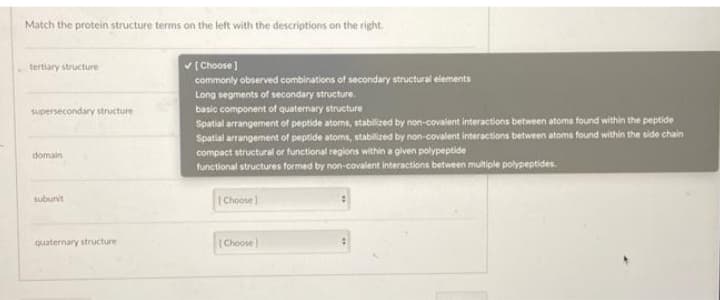Match the protein structure terms on the left with the descriptions on the right. v(Choose) commonly observed combinations of secondary structural elements tertiary structure Long segments of secondary structure. suoenecondary structure basic component of quaternary structure Spatial arrangement of peptide atoms, stabilized by non-covalent interactions between atoms found within the peptide Spatial arrangement of peptide atoms, stabilized by non-covalent interactions between atoms found within the side chain domain compact structural or functional regions within a given polypeptide functional structures formed by non-covalent interactions between multiple polypeptides (Choose subunit quaternary structure {Choose)
Match the protein structure terms on the left with the descriptions on the right. v(Choose) commonly observed combinations of secondary structural elements tertiary structure Long segments of secondary structure. suoenecondary structure basic component of quaternary structure Spatial arrangement of peptide atoms, stabilized by non-covalent interactions between atoms found within the peptide Spatial arrangement of peptide atoms, stabilized by non-covalent interactions between atoms found within the side chain domain compact structural or functional regions within a given polypeptide functional structures formed by non-covalent interactions between multiple polypeptides (Choose subunit quaternary structure {Choose)
Chapter15: Proteins And Amino Acids
Section: Chapter Questions
Problem 12RQ
Related questions
Question

Transcribed Image Text:Match the protein structure terms on the left with the descriptions on the right.
v (Choose )
commonly observed combinations of secondary structural elements
tertiary structure
Long segments of secondary structure.
supersecondary structure
basic component of quaternary structure
Spatial arrangement of peptide atoms, stabilized by non-covalent interactions between atoms found within the peptide
Spatial arrangement of peptide atoms, stabilized by non-covalent interactions between atoms found within the side chain
compact structural or functional regions within a given polypeptide
functional structures formed by non-covalent interactions between multiple polypeptides.
domain
(Choosel
subunit
quaternary structure
(Choose)
Expert Solution
This question has been solved!
Explore an expertly crafted, step-by-step solution for a thorough understanding of key concepts.
This is a popular solution!
Trending now
This is a popular solution!
Step by step
Solved in 2 steps

Recommended textbooks for you

